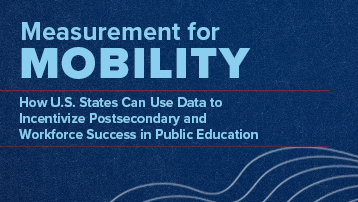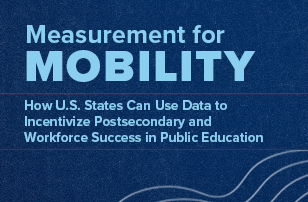Education is a huge investment for states and students. In 2023 alone, U.S. states spent over $360 billion on K-12 education and $120 billion on higher education in part to prepare 49 million public K-12 students and 7.6 million public 2-year, 4- year, and PAB students for postsecondary and workforce success.
States are collecting and analyzing data on outcomes to maximize the return on these significant investments. But what data are they tracking, how are they using it, and what best practices can be shared to enhance and scale success?
To answer these questions, American Student Assistance® (ASA) and the Education Strategy Group (ESG) recently published Measurement for Mobility, a report on how states are measuring and supporting the long-term success of K-12 and higher education students in their reporting, accountability, and incentives systems.
The report found that in K-12:
- All states publicly report College and Career Readiness data and nearly all states publicly report Postsecondary Outcomes.
- The vast majority of states incorporate College and Career Readiness Metrics into their federal or state accountability systems, but less than 10 incorporate Postsecondary Outcomes into their accountability systems.
- Only a few states have included College and Career Readiness Metrics or Postsecondary Outcomes in funding incentives.
With regards to higher education institutions:
- Almost all states are publicly reporting College Success Outcomes.
- States are more likely to share Workforce Outcomes in no-stakes public reporting.
- Almost 50% of states have funding incentives but the metrics used and the weights associated with them vary.
Based on this state scan, the report recommends state leaders make long-term success metrics a priority in both K-12 and higher education by including data on College and Career Readiness, Postsecondary Outcomes, College Success Outcomes, and Workforce Outcomes in their next-generation measurement and accountability systems, giving them sufficient weight, and segmenting data by demographic groups.
In this three-part blog series, we will do a deep dive into the reports’ K-12 findings, higher education findings, and recommendations for state leaders. Below we begin with K-12.
K-12 Long-Term Student Success Metrics
States have been collecting data on K-12 student progress for decades. And when the Every Student Succeeds Act (ESSA) passed in 2015, Student Success data became a required part of the mix.
The research identified two types of long-term Student Success Outcome data that states are monitoring and incorporating into their measurement and incentive systems:
- College and Career Readiness Metrics – This category includes a wide range of data points collected during a student’s high school years that are believed to influence and predict a student’s success in postsecondary education, the workforce, and the military.
Some examples are success in postsecondary opportunities (e.g. completion of AP or IB course or exams, passing dual credit/enrollment courses, etc.) and other high-quality CTE pathways, participation in work-based learning experiences, and/or attainment of industry-based credentials and certificates during high school. College access measures such as college application and/or acceptance rates, as well as FAFSA and/or scholarship completion rates, may also be included.
- Postsecondary Outcomes – This data is captured after students graduate from high school and can be challenging to track if students enroll in out-
Data subcategories include College Success Outcomes like postsecondary enrollment in two- or four-year colleges or training programs, readiness for non-remedial coursework, persistence rates, gateway course completion, credit accumulation, GPA, and pass rates; Workforce Outcomes such as wages earned post-graduation and employment rates; and Military Outcomes (enlistment percentages).
How States are Using Metrics
Public Reporting
States use Student Success Outcome data in a variety of ways (see Table 1), with the most common being public reporting. While all states share some College and Career Readiness Metrics or Postsecondary Outcomes publicly (43 states + D.C. report both, 4 states report only College and Career Readiness Metrics, and 3 states report only Postsecondary Outcomes), the information is not always easy to find.
TABLE 1: How States Use Postsecondary and Workforce Success Data
| Use | College & Career Readiness Metrics | Postsecondary Outcomes |
| Public Reporting (available to the public and have no formal stakes) | 47 states + D.C | 46 states + D.C. |
| Accountability (data-based measurement systems that include formal consequences) | 41 states + D.C. | 8 states |
| Funding Incentives (Systems that award state funding if target outcomes are met) | 7 states | 2 states |
| Other Mechanisms (Data that influences behavior and outcomes but does not fall into other categories) | 25 states + D.C. | 1 state |
Accountability
While public reporting provides some accountability through transparency, it is a low stakes approach because it does not come with formal consequences. Federal accountability via ESSA and state accountability systems tie actions to metrics and have a more direct impact.
The vast majority of states (41 + D.C.) include College and Career Readiness Metrics in their accountability systems, but only eight include Postsecondary Outcomes.
In any accountability system, College and Career Readiness Metrics and Postsecondary Outcomes make up only a portion of a district’s score. It, along with the other included metrics, is “weighted” or assigned a percentage of points that it contributes to the overall rating. The higher the weight, the more it counts and influences priorities and behaviors. Since ESSA requires that the majority of points be allocated to academic indicators, most states weight College and Career Readiness Metrics in the 10-20 percent range and Postsecondary Outcomes in the 1-10 percent range.
Colorado, which allocates 30 percent of points to College and Career Readiness Outcomes and 2.3 percent to Postsecondary Outcomes for state accountability, is a notable exception. And Vermont allocates 10 percent of points based on College and Career Readiness Outcomes and 10 percent based on Postsecondary Outcomes (the highest weight across all states) in its federal accountability metric.
Funding Incentives
Incentivizing districts and schools to prioritize long-term outcomes for students is a relatively new approach for states. Only seven states do so thus far with four states tying funding to the number of students earning industry-based credentials while in high school.
Some promising practices include:
- Colorado’s Career Development Incentive Program gives schools up to $1,000 each time a student completes an industry certification linked to a high-demand job; completes a postsecondary internship, residency, or apprenticeship program tied to key industry needs; or completes an AP computer science course. During the program’s first six years, the number of participating students quadrupled to 12,573 of which 40 percent are BIPOC.
- Texas’ College, Career, and Military Readiness Outcomes Bonus pays districts a bonus for the number of students above a threshold that earns a qualifying test score and an associate degree prior to high school graduation or enrolls in postsecondary education following it; earns a qualifying test score and a qualifying industry credential or certificate; or earns a qualifying score on the Armed Services Vocational Aptitude Battery and enlists in the miliary. Bonus amounts vary depending on if a student is economically disadvantaged or has special needs.
- Indiana’s House Bill 1001 offers districts a menu of incentives for every dual enrollment or dual credit hour earned, every graduate earning an approved credential or the Indiana College Core 30, or every student earning an associate degree by graduation.
K-12 Key Takeaways
While states are making a significant effort to prioritize College and Career Readiness Metrics, the report finds only a handful of states are including Postsecondary Outcomes in their K-12 accountability systems and funding incentives. Although post high school graduation data may be harder to track, it plays a critical role in states’ ROI calculations as well as a students’ long-term success.
To learn how higher education is using metrics for postsecondary and workforce success, as well as recommendations that state leaders and policymakers designing next-generation measurement and accountability systems should observe, stay tuned for parts two and three of this blog series.




